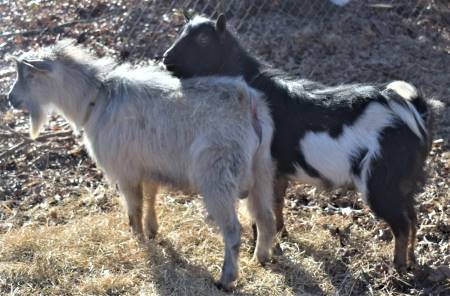Lactic Acidosis (Grain Overload)
Lactic Acidosis (Grain Overload)
by Robert Van Saun, DVM, MS, PhD Department of Veterinary Science Pennsylvania State University
AppleJo Farms Note: "I had a doeling a couple years ago, who was getting pushed out at feed time and couldn't get her grain. I thought I'd help by letting her eat grain out of the bin while I did chores, not realizing how much she was eating. After a few days of this, I noticed her standing off by herself and not eating. I acted immediately and after doing the research, determined it was Lactic Acidosis or Grain Overload. I administered CD Antitoxin (first 2 doses 6 hours apart) and the next at 24 hours from first dose.) By the next day she was 50% improved and by 48 hours, completely improved. Never since have I let a goat overeat grain!"
Clinical Signs. Simple indigestion may be the first indication of a lactic acidosis problem. Any goat eating solid feed containing concentrate is potentially susceptible to ruminal acidosis. In mild to moderate cases the goat will back off feed, especially grain, usually only for one feeding. One may observe a slug feeding behavior where does eat well one day, then back off and repeat the cycle.
More chronic acidosis problems will manifest as variable appetite, depressed milk fat and chronic laminitis. Toes grow abnormally fast with "rings". Acute laminitis shows up as painful feet. The quality of the horn is poor and flaky. Goats may be lame and prone to foot abscesses. In some cases, diarrhea will be present, smelling acidic and yellow in color.
With more severe acute lactic acidosis, protozoa and bacteria die, rumen becomes static and the goat becomes depressed and dehydrated. The rumen is fluid filled and "sloshy".
Acute lactic acidosis may result in death within hours or days. In very severe cases, there is no diarrhea because of total gut stasis. The goat may appear "drunk" and ataxic. Acute acidotic goats will be recumbent and look very similar to milk fever, i.e. cold with dilated pupils. Rumen examination (pH and examination of flora) need to be done to confirm a diagnosis.
Causes. The rumen ecosystem is comprised of more than 200 species of bacteria, protozoa, fungi and viruses. Bacterial species span the range of substrate fermented and end product formation. Lactic acid is one of many potential fermentation end products generated by sugar and starch fermenting bacteria. In normal rumen conditions, production of lactic acid is counterbalanced by its consumption by lactate fermenting bacteria. Lactic acid is a potentially deleterious product in the rumen as it will reduce pH to a point of suppressing bacteria responsible for fiber fermentation. Most bacteria in the rumen are pH sensitive, not being able to survive below pH of 6.0. In situations where excessive sugar or starch is consumed, lactic acid will be overproduced and accumulate, thus inducing a severe decline in rumen pH. As the rumen pH declines, Lactobacillus bacteria will start to proliferate generating more lactic acid. The animal becomes acidotic and loses fluids to the rumen, becoming dehydrated. The rumen system in best maintained on a consistent dietary regimen. Dramatic changes in dietary forage to concentrate ratio, total amount of concentrate fed and concentrate fermentability will be conducive to lactic acidosis situation. Fiber (e.g. hay or silage) is important in the diet as it stimulates the goat to chew, thus producing alkaline saliva serving to buffer the rumen. Diets with minimal fiber or chopped too finely are more at risk of lactic acidosis.
Treatment. With mild to moderate cases, symptomatic therapy along with a reduction in grain feeding may suffice. Injections of CD Antitoxin are necessary. Keep it in your Refrigerator on hand.
In severe acute cases treatment is heroic, intensive supportive care and surgical emptying of the rumen (rumenotomy). Supportive therapy includes intravenous and oral fluids, rumen transfaunation (rumen juice from a healthy animal), alkalinizing solutions for the rumen (only done with caution), antibiotics and nursing care. Even if one recovers an affected goat, secondary problems related to bacterial and fungal infections of the liver and rumen wall need to be addressed.
Prevention. Inadvertent accessability to grain storage must be prevented. Grain feeding within a diet must be controlled and managed appropriately. Processed grains need to be carefully managed to prevent acidosis as they are more readily available for fermentation in the rumen. Grains should never be fed prior to a forage meal as forage consumption initiates salivary buffering. If grain accessability is separate from forage feeding, grain feedings should be divided into 3 or more separate feedings depending upon the amount needed to support production level. Problems with grain feeding can be minimized by feeding a total mixed ration (TMR). Feed changes all need to be made gradually over several days so the flora have time to adapt.



Powered by Boutique Store Builder . Web Design by Avalon Rose Design.


